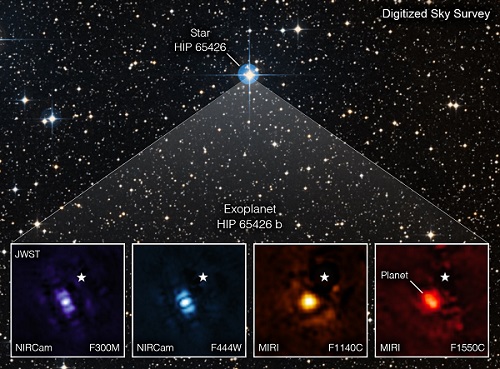
NASA Reveals First Exoplanet Images Taken by Webb Telescope
WASHINGTON, D.C., Sept. 6, 2022 — Astronomers from the University of Exeter in the U.K. used NASA’s James Webb Space Telescope to capture the first direct image of a planet outside our solar system. The image, shown through four different light filters, demonstrates how the telescope’s infrared capabilities can lead the way to observations that will reveal more information than previously possible about exoplanets.
“This is a transformative moment, not only for Webb but also for astronomy generally,” said Sasha Hinkley, associate professor of physics and astronomy at the university, who led the observations with a large international collaboration. Webb is an international mission led by NASA in collaboration with its partners, the European Space Agency and the Canadian Space Agency.
The imaged exoplanet is a gas giant called HIP 65426 b. It’s about six to 12× the mass of Jupiter, and the observations taken by Webb could help narrow this value down even further. The planet is fairly young, about 15 to 20 million years old. For comparison, Earth is about 4.5 billion years old.

The exoplanet HIP 65426 b in different bands of infrared light, as seen from the James Webb Space Telescope. The telescope's NIRCam instrument’s view at 3 mm (purple) and its view at 4.44 mm. The MIRI instrument’s view at 11.4 mm (yellow) and its view at 15.5 mm (red). The location of the host star HIP 65426 has been subtracted in each image using the coronagraphs and image processing (white stars). Artifacts of the telescope’s optics In the NIRCam images (bar shapes). Courtesy of NASA/ESA/CSA, A. Carter (UCSC), the ERS 1386 team, and A. Pagan (STScI).
The planet was discovered in 2017 using the SPHERE instrument on the European Southern Observatory’s Very Large Telescope in Chile, which took images of it using short infrared wavelengths of light. Webb’s images were taken at longer wavelengths and reveal new details unable to be detected by ground-based telescopes due to the intrinsic infrared glow of Earth’s atmosphere. Webb's images include details about the chemical composition of the planet’s atmosphere, which appears red due to silicate minerals forming a fine dust in the atmosphere.
The presence of most exoplanets has only been inferred using indirect methods, such as the transit method, in which some of the host star’s light is blocked by a planet passing in front. Directly imaging exoplanets has proven challenging, as the host stars around which the planet orbits are much brighter. The HIP 65426 b planet is more than 10,000× fainter than its host star in the near-infrared, and a few thousand times fainter in the mid-infrared.
However, because the planet is about 100× farther from its host star than Earth is from the sun, it’s sufficiently distant to be separated from the star in the image.
Webb’s Near-Infrared Camera (NIRCam) and Mid-Infrared Instrument (MIRI) are both equipped with coronagraphs, sets of tiny masks that block out starlight, enabling Webb to take direct images of certain exoplanets such as HIP 65426 b. NASA’s Nancy Grace Roman Space Telescope, slated to launch later this decade, will demonstrate an even more advanced coronagraph.
“Obtaining this image felt like digging for space treasure,” said Aarynn Carter, a postdoctoral researcher at the University of California, Santa Cruz, who led the analysis of the images. “At first all I could see was light from the star, but with careful image processing I was able to remove that light and uncover the planet.”
In each filter image, the planet appears as a slightly differently shaped blob of light because of the particulars of Webb’s optical system and how it translates light through the different optics.
“I think what’s most exciting is that we’ve only just begun,” Carter said. “There are many more images of exoplanets to come that will shape our overall understanding of their physics, chemistry, and formation. We may even discover previously unknown planets, too.”
The researchers are preparing a paper for peer review. A draft of their work is available on arXiv (www.doi.org/10.48550/arxiv.2208.14990).
Published: September 2022